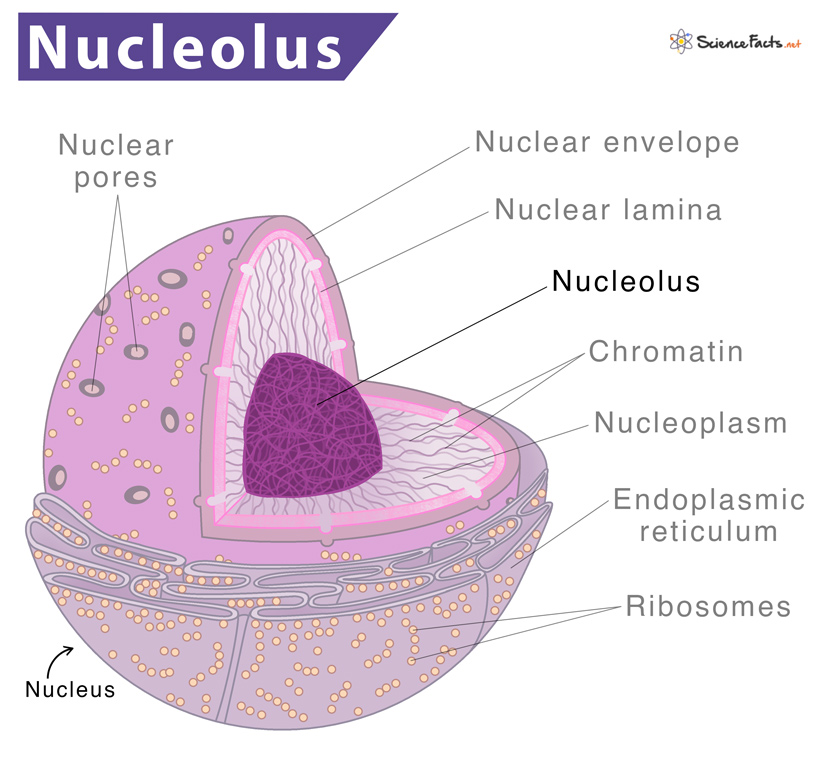Nucleolus
What is Nucleolus
The nucleolus (plural: nucleoli) is described as a large, round body located inside the matrix of the nucleus of a eukaryotic cell. It is membrane-less and is made up of RNA and proteins. The nucleolus is more prominently seen in an interphase nucleus.
Eukaryotic cells, plant or animal, often contain a single nucleolus, though several are also possible. The exact number is fixed among the members of the same species.
Each human diploid cell contains only one nucleolus formed at specific chromosome sites known as nucleolus organizer regions (NORs). The DNA found at chromosomal NORs encodes the genes for ribosomal RNA (rRNA). At the start of mitosis, the single nucleolus disappears and is again reassembled from 10 smaller nucleolus-like structures that develop from the NORs during the telophase and early G1 phase of the cell cycle.
When was the Nucleolus Discovered
The nucleolus was first identified long back in the eighteenth century. Little was known about its function until 1964 when John Gurdon and Donald Brown found nucleolus to have an essential purpose in life. Later in 1966, Max L. Birnstiel and collaborators found its function in rRNA synthesis.
Structure
The size of the nucleoli depends on the ribosomal requirement of the cell. The cell that produces more proteins contains a more prominent nucleolus than cells that require fewer proteins. If visualized through an electron microscope, a eukaryotic nucleolus appears like a large dark spot within the nucleus. A eukaryotic nucleolus is found to contain three major components:
- Fibrillar Center (FC): It is the place of ribosomal protein synthesis. FC is the place where the RNA polymerase I reside.
- Dense Fibrillar Component (DFC): Recently transcribed RNA connects to the ribosomal proteins. Processing of transcripts and coupling to small nucleolar ribonucleoproteins also occur in DFC.
- Granular Component (GC): Before ribosome synthesis, GC contains rRNA that binds to ribosomal proteins in GC, thus completing the ribosomal subunit assembly.
Apart from the above three ultrastructures, plant cells also contain nucleolar vacuoles containing fluids and water. The organization of the nucleolus can be studied using techniques such as fluorescent protein tagging and fluorescent recovery after photobleaching (FRAP).
Functions
The importance of the nucleolus is that it is considered the brain of the nucleus. It occupies a volume of almost 30% of the cell. Its primary roles are rRNA synthesis and the biogenesis of ribosomes.
The nucleolus contains the machinery necessary to assemble the cell’s ribosomal RNAs (rRNAs). RNAs are then transported through the nuclear pores into the cytoplasm. They then combine with proteins and become part of the ribosome by assembling the ribosomal subunits. A complete ribosome being the site of cell’s protein synthesis, the nucleolus also plays a vital role in making proteins.
Apart from the above vital functions, the nucleolus also regulates cell cycle, growth and development, senescence, telomerase activity, gene silencing, responses to biotic and abiotic stresses, and biogenesis of multiple ribonucleoprotein complexes.
Malfunction of the nucleolus is responsible for human diseases called nucleolopathies. It thus acts as a target for cancer therapy.
Additional Information
- When eukaryotic cells are viewed through a microscope, the nucleolus is prominent. Because of its size, the basic structure of the nucleolus was described as early between 1835 and 1839. It was long before Mendel discovered the laws of inheritance that genes are parts of the chromosome, or DNA is the cell’s genetic information.
- It took nearly 100 years after it was first identified to realize that the nucleolus is formed at a specific chromosomal location, known as nucleolus organizer regions (NORs). It is the site where ribosome assembly begins.
FAQs
Ans. No, since prokaryotes lack a nucleus, they do not have nucleolus.
Ans. The nucleolus is the most important organelle in the nucleus of a eukaryotic cell.
-
References
Article was last reviewed on Wednesday, April 6, 2022




